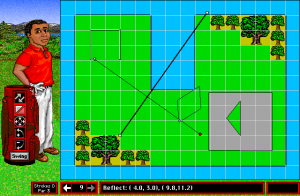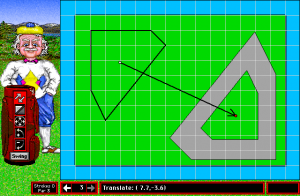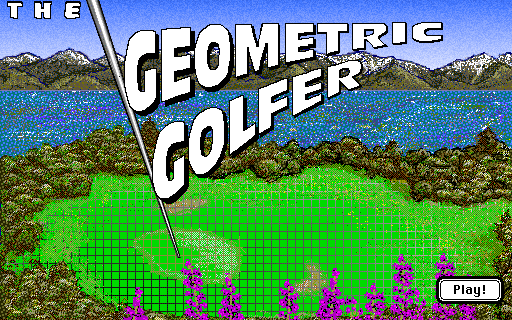The Geometric Golfer 


Educational games don’t need to teach for their players to learn. Often, edutainment finds success by introducing ideas and concepts in less direct ways, like engrossing you in a historical setting or raising situations related to the topic. Even by those open expectations, The Geometric Golfer seems tangential to an educational mission. The game uses the format of golf to familiarize players with geometrical transformations, though it approaches those concepts with a looseness that perhaps applies better to discovering facts than math problem-solving. Still, geometry is fun to play around with like this, and the freedom to experiment with shapes and motions brings some degree of comfort to a potentially intimidating subject.

Shooting under par calls for advanced strategies, like reflecting the ball at an angle
In each leg of The Geometric Golfer‘s courses, players must hit their ball – a polygonal shape of some sort – into a matching hole. On some stages you can just move the ball in (translating it, to use the geometric term), but you usually need to transform the ball by rotating, resizing, or reflecting it. As the courses grow more challenging, these moves also help you navigate trees and water obstacles in your path. The ball might need to shrink to go through a small passage, for instance, then dilate to fit into the hole.
You can usually just eyeball the transformations, which separates The Geometric Golfer from the actual math. The game offers coordinates for every point on-screen, ostensibly for calculations, but you never need that information and sometimes have barriers to using it. If the ball ends up slightly askew from the hole, you could theoretically grab some paper, plot out the shapes, and determine the best rotational point. That would be a tremendous waste of effort that the game discourages since instead, you can draw out an arc that looks close enough and hope for the best. No tool embodies this geometry-through-spitballing better than reflection guide, which indicates where the ball will travel with the same mathematical precision as measuring with your fingers.
At a point, the game drifts away from its learning goals for the sake of interesting challenges. The ten included courses steadily build difficulty as they go on, but the last handful feature especially tough holes that demand deeper knowledge of the game – though not usually deeper knowledge of geometry. The middle courses include some unusual shapes that require a keen awareness of transformations, but eventually, the focus shifts towards complex course layouts and your skill with the quirks of the game’s toolset.

Some holes teach geometry more overtly. Careful, the ball’s not symmetrical!
As instruction for geometry, The Geometric Golfer doesn’t achieve much. Its geometry-adjacent obstacles would probably not help players complete their homework. It does, however, create a comfortable, friendly space for experimenting with general geometric concepts. You may not know the significance of different types of angles after a few rounds, but you’ll understand how to visualize a shape turning or how to use a grid. It works more effectively as a primer or supplemental aid for dealing with geometry, not as the primary way to learn math. (And for younger folks learning tangibly with geoboards or other manipulatives, this might be enough.)
It also makes for a pretty fun golf game. Luckily for those who don’t just want to recap their middle school education, The Geometric Golfer‘s gradual difficulty provides a good excuse to play through the whole thing (assuming you can wrap your head around the tools). The game-ier aspects may sometimes distract from the educational side, but the consistently clever courses expand on the variety found in other simplified golf games.
By the end, you will probably have learned less about geometry than about how to play The Geometric Golfer. That’s fine if you have no investment in taking away math skills. Its secret educational potential comes from how tossing around polygons for half an hour can instill confidence and comfort with the idea of transformations. Though maybe you’d still need a teacher remind you what a 90-degree angle is.
Trivia!
The Geometric Golfer includes a course creator for those who want to make something even more dastardly or geometrically stimulating than the default package. (Knowing the sorts of shenanigans kids can get into when given any level of creative freedom, the game also lets you disable that feature.)


Dude. Oh. My. Lord. I have been looking for this game for YEARS! Even screenshots or mentions of it have eluded me. Played this back in the 90s when it was first released. So much fun, and prepared me for Kirby’s Dream Course (SNES)!
Dear Sir, do you happen to have a location where I may purchase or obtain this software?
Have a great day,
Christopher
P.S. Found this site by looking for “Flying Colors.” What a treasure trove!
Along with many other MECC games, The Geometric Golfer isn’t being sold anymore, but there are copies floating around online like on Macintosh Repository. It’s designed for old Macs, so you’ll have to use a Macintosh emulator. E-Maculation has good tutorials on how to set up SheepShaver, the most popular Mac emulator. I’ve put other guides and software for Mac emulation in the Resources tab at the top of the page.
Keep it mind it might be a time investment to get everything working.
(Thank you for reading!)
I think it’s an injustice that this game never got made for Windows PCs and stayed a Mac-exclusive instead. What could possibly have prevented MECC from bringing it to the then-growing Windows market, especially with the newly-released or to-be-released Windows 3.1?